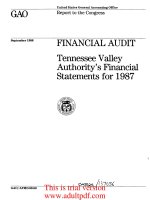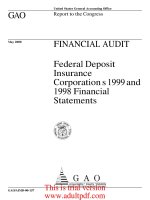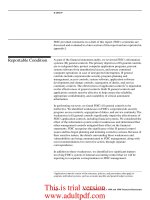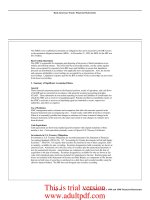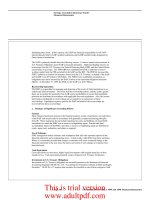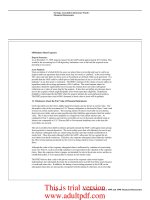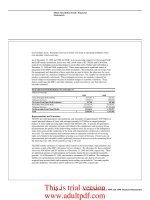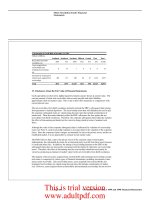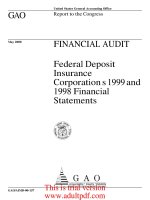United States General Accounting Office GAO May 2000 Report to the Congress FINANCIAL AUDIT_part5 docx
Bạn đang xem bản rút gọn của tài liệu. Xem và tải ngay bản đầy đủ của tài liệu tại đây (33.41 KB, 2 trang )
Savings Association Insurance Fund’s
Financial Statements
Page 39 GAO/AIMD-00-157 FDIC’s 1999 and 1998 Financial Statements
liquidating their assets. In this capacity, the SAIF has financial responsibility for all SAIF-
insured deposits held by SAIF-member institutions and by BIF-member banks designated as
Oakar financial institutions.
The SAIF is primarily funded from the following sources: 1) interest earned on investments in
U.S. Treasury obligations and 2) SAIF assessment premiums. Additional funding sources are
borrowings from the U.S. Treasury, the Federal Financing Bank (FFB), and the Federal Home
Loan Banks, if necessary. The 1990 OBR Act established the FDIC's authority to borrow
working capital from the FFB on behalf of the SAIF and the BIF. The FDICIA increased the
FDIC's authority to borrow for insurance losses from the U.S. Treasury, on behalf of the SAIF
and the BIF, from $5 billion to $30 billion. The FDICIA also established a limitation on
obligations that can be incurred by the SAIF, known as the maximum obligation limitation
(MOL). At December 31, 1999, the MOL for the SAIF was $16.7 billion.
Receivership Operations
The FDIC is responsible for managing and disposing of the assets of failed institutions in an
orderly and efficient manner. The assets held by receivership entities, and the claims against
them, are accounted for separately from SAIF assets and liabilities to ensure that liquidation
proceeds are distributed in accordance with applicable laws and regulations. Also, the income
and expenses attributable to receiverships are accounted for as transactions of those
receiverships. Liquidation expenses paid by the SAIF on behalf of the receiverships are
recovered from those receiverships.
2. Summary of Significant Accounting Policies
General
These financial statements pertain to the financial position, results of operations, and cash flows
of the SAIF and are presented in accordance with generally accepted accounting principles
(GAAP). These statements do not include reporting for assets and liabilities of closed thrift
institutions for which the FDIC acts as receiver or liquidating agent. Periodic and final
accountability reports of the FDIC's activities as receiver or liquidating agent are furnished to
courts, supervisory authorities, and others as required.
Use of Estimates
FDIC management makes estimates and assumptions that affect the amounts reported in the
financial statements and accompanying notes. Actual results could differ from these estimates.
Where it is reasonably possible that changes in estimates will cause a material change in the
financial statements in the near term, the nature and extent of such changes in estimates have
been disclosed.
Cash Equivalents
Cash equivalents are short-term, highly liquid investments with original maturities of three
months or less. Cash equivalents primarily consist of Special U.S. Treasury Certificates.
Investments in U.S. Treasury Obligations
Investments in U.S. Treasury obligations are recorded pursuant to the Statement of Financial
Accounting Standards (SFAS) No. 115, “Accounting for Certain Investments in Debt and Equity
Securities.” SFAS No. 115 requires that securities be classified in one of three categories: held-
This is trial version
www.adultpdf.com
Savings Association Insurance Fund’s
Financial Statements
Page 41 GAO/AIMD-00-157 FDIC’s 1999 and 1998 Financial Statements
the BIF (resulting in an exit fee). Regulations approved by the FDIC's Board of Directors
(Board) and published in the Federal Register on March 21, 1990, directed that exit fees paid to
theSAIFbeheldinescrow.
The FDIC and the Secretary of the Treasury will determine when it is no longer necessary to
escrow such funds for the payment of interest on obligations previously issued by the FICO.
These escrowed exit fees are invested in U.S. Treasury securities pending determination of
ownership. The interest earned is also held in escrow. There were no conversion transactions
during 1999 and 1998 that resulted in an exit fee to the SAIF.
U.S. Treasury Obligations, Net at December 31, 1999 (Restricted for SAIF-Member Exit Fees)
Dollars in Thousands
Stated Unrealized Unrealized
Yield at Face Amortized Holding Holding Market
Maturity Purchase Value Cost Gains Losses Value
1-3 years 5.90% $ 115,000 $ 115,336 $ 0 $ (876) $ 114,460
3-5 years 6.30% 55,000 56,131 217 (582) 55,766
5-10 years 5.20% 64,000 68,508 0 (5,265) 63,243
Total $ 234,000 $ 239,975 $ 217 $ (6,723) $ 233,469
Held-to-Maturity
Cash and Other Assets: Restricted for SAIF-Member Exit Fees at December 31
Dollars in Thousands
1999 1998
Cash and cash equivalents $
23,302
$ 55,248
Investment in U.S. Treasury obligations, net
239,975
193,350
Interest receivable on U.S. Treasury obligations
4,529
4,190
Exit fees receivable
684
1
,002
Total $ 268,490 $ 253,790
This is trial version
www.adultpdf.com
